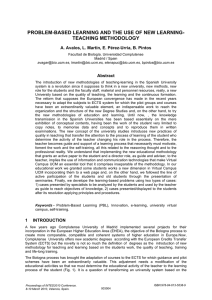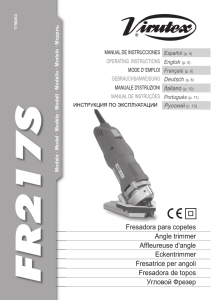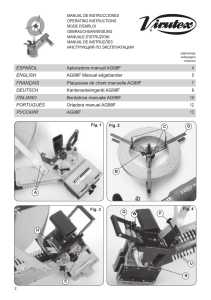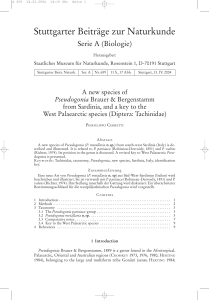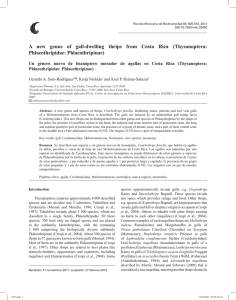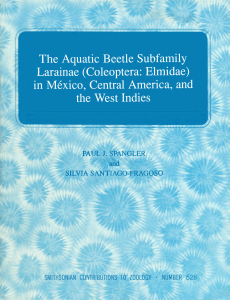Ten new species of cavernicolous Tribasodites from China and
Anuncio
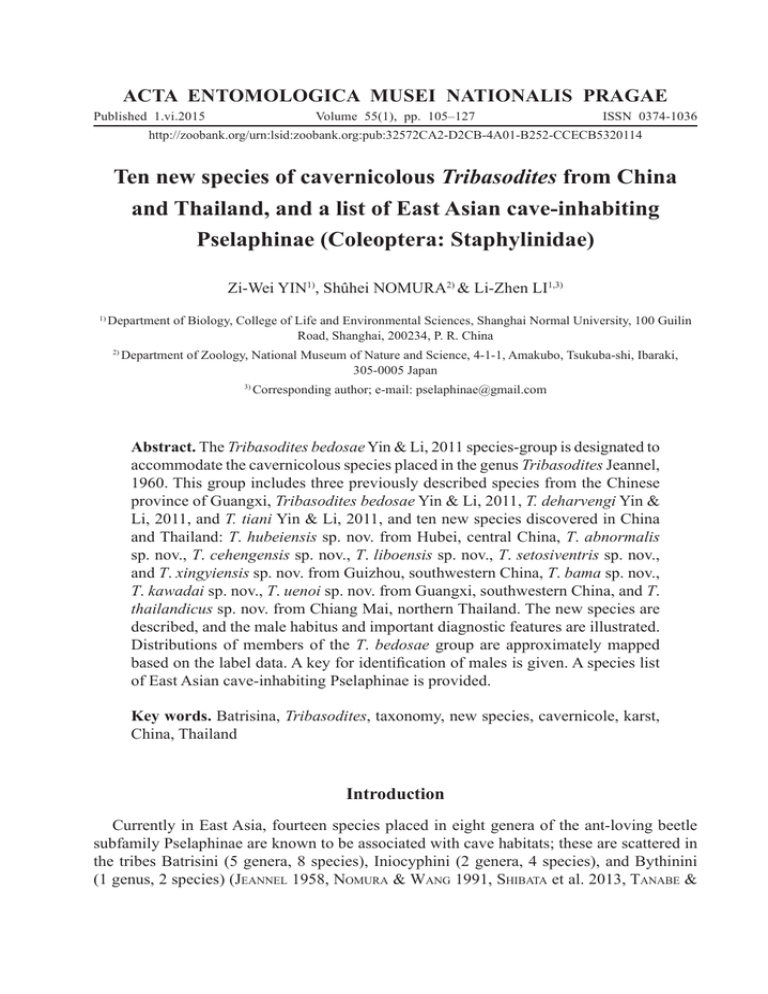
ACTA ENTOMOLOGICA MUSEI NATIONALIS PRAGAE Published 1.vi.2015 Volume 55(1), pp. 105–127 ISSN 0374-1036 http://zoobank.org/urn:lsid:zoobank.org:pub:32572CA2-D2CB-4A01-B252-CCECB5320114 Ten new species of cavernicolous Tribasodites from China and Thailand, and a list of East Asian cave-inhabiting Pselaphinae (Coleoptera: Staphylinidae) Zi-Wei YIN1), Shûhei NOMURA2) & Li-Zhen LI1,3) 1) Department of Biology, College of Life and Environmental Sciences, Shanghai Normal University, 100 Guilin Road, Shanghai, 200234, P. R. China 2) Department of Zoology, National Museum of Nature and Science, 4-1-1, Amakubo, Tsukuba-shi, Ibaraki, 305-0005 Japan 3) Corresponding author; e-mail: [email protected] Abstract. The Tribasodites bedosae Yin & Li, 2011 species-group is designated to accommodate the cavernicolous species placed in the genus Tribasodites Jeannel, 1960. This group includes three previously described species from the Chinese province of Guangxi, Tribasodites bedosae Yin & Li, 2011, T. deharvengi Yin & Li, 2011, and T. tiani Yin & Li, 2011, and ten new species discovered in China and Thailand: T. hubeiensis sp. nov. from Hubei, central China, T. abnormalis sp. nov., T. cehengensis sp. nov., T. liboensis sp. nov., T. setosiventris sp. nov., and T. xingyiensis sp. nov. from Guizhou, southwestern China, T. bama sp. nov., T. kawadai sp. nov., T. uenoi sp. nov. from Guangxi, southwestern China, and T. thailandicus sp. nov. from Chiang Mai, northern Thailand. The new species are described, and the male habitus and important diagnostic features are illustrated. Distributions of members of the T. bedosae group are approximately mapped based on the label data. A key for identification of males is given. A species list of East Asian cave-inhabiting Pselaphinae is provided. Key words. Batrisina, Tribasodites, taxonomy, new species, cavernicole, karst, China, Thailand Introduction Currently in East Asia, fourteen species placed in eight genera of the ant-loving beetle subfamily Pselaphinae are known to be associated with cave habitats; these are scattered in the tribes Batrisini (5 genera, 8 species), Iniocyphini (2 genera, 4 species), and Bythinini (1 genus, 2 species) (JEANNEL 1958, NOMURA & WANG 1991, SHIBATA et al. 2013, TANABE & 106 YIN et al.: New cavernicolous Tribasodites from China (Staphylinidae) NAKANE 1989, TANOKUCHI 1990, YIN et al. 2011a). The cavernicolous fauna of Batrisini is classified into three genus-groups: the Batrisus-, the Tribasodes-, and the Batrisocenus-groups (sensu NOMURA & IDRIS 2003). The Batrisus group includes two genera, Batrisodellus Jeannel, 1958 (2 species) and Speobatrisodes Jeannel, 1958 (1 species), which are known only from Japan (JEANNEL 1958, TANABE & NAKANE 1989). Other cavernicolous species known to occur in southern part of East Asia are placed in the genera Tribasodes Jeannel, 1958, Tribasodites Jeannel, 1960, and Tribasodellus Nomura & Yin, 2011 of the Tribasodes group. Tribasodes kamedai Nomura, 2012 from the Okinawa Island, southwestern Japan was the most recently described species in Asia (NOMURA 2012; YIN et al. 2011a, 2011b). In China, four species placed in two genera have been known since the end of the 20th century. The first, Batrisodellus callissimus Nomura & Wang, 1991, was described from several limestone caves in Guangxi (NOMURA & WANG 1991). Ten years later, this species was transferred to a new genus, Tribasodellus Yin & Nomura, 2011 (YIN et al. 2011b). In the same year, three new cavernicolous species of Tribasodites, T. bedosae Yin & Li, 2011, T. deharvengi Yin & Li, 2011, and T. tiani Yin & Li, 2011, were described based on material collected during the 2005 and 2007 Sino-French biological surveys in Mulun and Yachang Nature Reserves, Guangxi (YIN et al. 2011a). In addition, an undescribed cavernicolous genus containing a few species of the Batrisocenus group is known to occur in southern part of the country (Nomura, unpublished data). A large number of caves are known in the karst regions of eastern, central, and southwestern China; thus the number of species will no doubt significantly grow in the future when these areas are properly sampled. In the collections of the National Museum of Nature and Science, Tokyo, and the Muséum d’Histoire Naturelle de la Ville de Genève, the authors spotted a series of unidentified batrisines collected in the caves in central to southern China and northern Thailand, and identified ten new species of the genus Tribasodites. All these species represent typical suite of morphological adaptations to life in caves and are closely related to the three previously described congeners from Guangxi. Thus, a new ‘Tribasodites bedosae species-group’ is designated to accommodate these cavernicolous members placed in Tribasodites. Material and methods The collecting data of the material are quoted verbatim. Labels contain ‘Shi’, ‘Xian’, ‘Zhen’, ‘Cun’, and ‘Dong’, which are phonetic notation for the transcription of the Mandarin dialect, equaling ‘City’, ‘County’, ‘Town’, ‘Village’, and ‘Cave’, respectively. Authors’ notes are placed in braces ({}). A single slash (/) separates data on different labels. Each type specimen is provided with an additional type label: ‘HOLOTYPE {red} (or PARATYPE {yellow}), Tribasodites + specific name sp. n., det. Yin & Nomura, 2014, NSMT (or MHNG)’. The terminology follows CHANDLER (2001), except we use ‘ventrite’ instead of ‘sternite’ when describing meso- and metathoracic structures. The following abbreviations are used: AL – length of the abdomen along the midline; AW – maximum width of the abdomen; EL – length of the elytra along the sutural line; EW – maximum width of the elytra; HL – length of the head from the anterior clypeal margin to Acta Entomologica Musei Nationalis Pragae, 55(1), 2015 107 the occipital constriction; HW – width of the head across eyes; PL – length of the pronotum along the midline; PW – maximum width of the pronotum. Length of the body is a combination of HL + PL + EL + AL. Studied material is deposited in Muséum d’Histoire Naturelle, Genève, Switzerland (MHNG) and National Museum of Nature and Science, Tokyo, Japan (NSMT). Taxonomy Tribasodites Jeannel, 1960 Tribasodites Jeannel, 1960: 411. Type species. Tribasodites antennalis Jeannel, 1960 Diagnosis. Head rectangular; with median longitudinal carina on vertex; lacking frontal rostrum; ocular-mandibular carinae distinct. Pronotum with median and lateral longitudinal sulci, lateral sulci usually carinate at inner margins, disc with additional pair of thin carinae between median and lateral sulci; with median antebasal impression and lateral antebasal foveae separated by antebasal spines; acute small spines often present on lateral margins (lacking in several cavernicolous species). Elytra each with three basal foveae, discal striae extending past half elytral length; subhumeral foveae present, marginal striae from foveae to elytral posterior margin. Abdomen with tergite IV (first visible tergite) longer than the next, inner marginal carinae extending throughout whole length of tergite, outer carinae slightly shorter than inner carinae, extending to near posterior margin of tergite; tergites V–VI each with single thin marginal carina. Differential diagnosis. The genus Tribasodites can be separated from the allied genus Tribasodes by the lack of a basal depression on the abdominal tergite IV, and by having the sexual character on the frons or the antennomeres VIII–XI in general. On the other hand, Tribasodites can be easily separated from the genus Tribasodellus by the transverse and laterally protuberant and/or spinose pronotum, while Tribasodellus has the pronotum longer than wide, feebly arcuate laterally and lacking spines. Tribasodites bedosae species-group Diagnosis. Cavernicolous Tribasodites with slender habitus and elongate antennae and legs. Males of all, except T. abnormalis sp. nov., have strongly modified antennomeres VIII–XI. A few species have strongly reduced eyes. Metaventrite modified, often with a pair of rows of dense setae anterior to metacoxae, or setae tufted instead of arranged in rows, or occasionally only sparsely covered. Aedeagus usually with median lobe split apically, with broad dorsal lobe, parameres attached to base of the median lobe, with distinct basoventral projection. Females lack any modification, and can be properly identified only if associated with the males, or sometimes by a combination of the forms of tergite VIII, sternite VIII, and genital complex. Included species. Thirteen species from China and Thailand are included: T. abnormalis sp. nov., T. bama sp. nov., T. bedosae Yin & Li, 2011, T. cehengensis sp. nov., T. deharvengi Yin & Li, 2011, T. hubeiensis sp. nov., T. kawadai sp. nov., T. liboensis sp. nov., T. setosi- 108 YIN et al.: New cavernicolous Tribasodites from China (Staphylinidae) ventris sp. nov., T. thailandicus sp. nov., T. tiani Yin & Li, 2011, T. uenoi sp. nov., and T. xingyiensis sp. nov. Comments. Except for T. abnormalis sp. nov., which has simple antennae and modified vertex, all males of this group are morphologically similar to each other. They can be separated only based on a combination of the following features: (1) shape of the aedeagus, (2) presence/absence of the pronotal lateral spines, (3) setation on metaventrite, (4) shape of the antennomeres VIII–XI, and (5) their distribution. An identification key is provided below. Tribasodites hubeiensis sp. nov. (Figs 1, 12A–C, 13A) Type locality. China, Hubei, Yichang Shi, Huanghua Xiang, Xingping Cun, Qingrenquan Dong. Type material. HOLOTYPE: , ‘Qingrenquan Dong (180 m), Xingping Cun, Huanghua Xiang, Yichang Shi, [Hubei, CHINA], 24.vi.2010, Hiroshi Miyama’ (NSMT). PARATYPES: 2 , same label data as holotype (NSMT); 1 , ‘Shikumen Dong, Songping Cun, Yezhou Zh., Jianshi Xian, [Hubei, CHINA], 26.vi.2010, Hiroshi Miyama’ (NSMT). Diagnosis. Male: vertex simple, lacking modification; antennomeres VIII–XI modified; each eye composed of about 50 facets; pronotum with distinct lateral spines; metaventrite raised above metacoxae to form ridges, with dense setae along ridges; aedeagus with apical portion of the median lobe split to two parts, the dorsal part much shorter than the ventral part. Female: each eye composed of about 15 facets; may be identified by the association with male. Description. Male. Body (Fig. 1A) reddish brown, mouth parts, antennae and tarsi paler; BL 2.97 mm. HL 0.59–0.60 mm, HW 0.62–0.63 mm; median longitudinal carina extending from base to level of eyes; each eye composed of about 50 facets; antennomeres VIII–IX modified (Fig. 1B). Pronotum slightly wider than long, PL 0.60–0.63 mm, PW 0.66–0.68 mm; with distinct discal and lateral spines. Elytra slightly wider than long, EL 0.90–0.91 mm, EW 0.94–0.95 mm; discal striae extending to apical 4/5 elytral length. Metaventrite (Fig. 1C) strongly raised above metacoxae, with pair of rows of dense setae; metacoxae and metatrochanters simple. Abdomen narrower than elytra, AL 0.85–0.86 mm, AW 0.88–0.84 mm. Aedeagus (Figs 1D, E) asymmetric, length 0.66 mm. Female. Similar to male in general; each eye with about 15 facets; antennae and metaventrite simple. Tergite VIII (Fig. 12A) and sternite VIII (Fig. 12B) transverse; width of genital complex excluding lateral arms (Fig. 12C) 0.12 mm. Measurements: BL 2.65 mm; HL 0.57–0.58 mm, HW 0.56–0.57 mm, PL 0.57–0.58 mm, PW 0.63–0.64 mm, EL 0.77–0.80 mm, EW 0.87–0.88 mm, AL 0.71–0.72 mm, AW 0.79–0. 82 mm. Etymology. The new species is named after the province where the type locality lies; adjective. Distribution. Central China: Hubei (Fig. 13A). Tribasodites abnormalis sp. nov. (Figs 2, 13A) Type locality. China, Guizhou, Libo Xian, Wengang X., Liangzhaixin, Bonong Dong. Type material. HOLOTYPE: , ‘Bonong Dong Cave (740 m), Liangzhaixin, Wengang X., Libo Xian, [Guizhou, CHINA] / {locality repeated in Chinese character} 31.x.2000, T. Kishimoto lg.’ (NSMT). Diagnosis. Male: vertex modified, covered with patches of dense setae; antennomeres VIII–XI simple; each eye composed of about 25 facets; pronotum lacking lateral spines; metaventrite Acta Entomologica Musei Nationalis Pragae, 55(1), 2015 109 Fig. 1. Tribasodites hubeiensis sp. nov., male. A – habitus. B – left antenna. C – meso- and metaventrite. D – aedeagus, in lateral view. E – aedeagus, in ventral view. Scales: A = 1.0 mm; C = 0.5 mm; B, D, E = 0.2 mm. raised above metacoxae to form ridges, setae mostly dense at posterior portion of the ridges; aedeagus with apical portion of the median lobe not split to two parts. Description. Male. Body (Fig. 2A) reddish brown, mouth parts, antennae and tarsi paler; BL 2.93 mm. HL 0.58 mm, HW 0.59 mm; median longitudinal carina extending from base to level of eyes; each eye composed of about 25 facets; antennomeres VIII–IX simple (Fig. 2B). Pronotum about as long as wide, PL 0.62 mm, PW 0.60 mm; lacking discal and lateral spines. Elytra slightly wider than long, EL 0.84 mm, EW 0.89 mm; discal striae short, extending through 1/3 of elytral length. Metaventrite (Fig. 2C) raised above metacoxae, with longitudinal carinae covered with dense setae; metacoxae and metatrochanters simple. Abdomen narrower 110 YIN et al.: New cavernicolous Tribasodites from China (Staphylinidae) Fig. 2. Tribasodites abnormalis sp. nov., male. A – habitus. B – left antenna. C – meso- and metaventrite. D – aedeagus, in lateral view. E – aedeagus, in ventral view. Scales: A = 1.0 mm; C = 0.5 mm; B, D, E = 0.2 mm. than elytra, AL 0.89 mm, AW 0.82 mm. Aedeagus (Figs 2D, E) asymmetric, length 0.56 mm. Female. Unknown. Etymology. The species epithet refers to the simple male antennae, a unique feature within the group; adjective. Distribution. Southwest China: Guizhou (Fig. 13A). Tribasodites cehengensis sp. nov. (Figs 3, 12D–F, 13A) Type locality. China, Guizhou, Ceheng Xian, Rongdu Zhen, Rongdu Cun, Hetou Dong. Type material. HOLOTYPE: , ‘Hetou Dong, 1030 m, Rongdu Cun, Rongdu Zhen / Ceheng Xian, SW. GUIZHOU, 24-V-2006, M. Nakanishi’ (NSMT). PARATYPES: 2 , same label data as holotype (NSMT); 1 1 , same label data, except ‘R. Oshitani’ (NSMT). Acta Entomologica Musei Nationalis Pragae, 55(1), 2015 111 Fig. 3. Tribasodites cehengensis sp. nov., male. A – habitus. B – left antenna. C – meso- and metaventrite. D – aedeagus, in lateral view. E – aedeagus, in ventral view. Scales: A = 1.0 mm; C = 0.5 mm; B, D, E = 0.2 mm. Diagnosis. Male: vertex simple, lacking modification; antennomeres VIII–XI modified; each eye composed of about 40 facets; pronotum with distinct small lateral spines; metaventrite raised above metacoxae to form humps, with dense setae at anterior half of the humps; aedeagus with apical portion of the median lobe split to two parts, the dorsal part much shorter than the ventral part. Female: each eye composed of about 15 facets; may be identified by the association with male. Description. Male. Body (Fig. 3A) reddish brown, mouth parts, antennae and tarsi paler; BL 2.82–2.89 mm. HL 0.58–0.60 mm, HW 0.59–0.60 mm; median longitudinal carina extending from base to level of eyes; each eye composed of about 40 facets; antennomeres VIII–IX modified (Fig. 3B). Pronotum about as long as wide, PL 0.58–0.59 mm, PW 0.57–0.60 mm; with small discal and lateral spines. Elytra slightly wider than long, EL 0.85–0.86 mm, EW 112 YIN et al.: New cavernicolous Tribasodites from China (Staphylinidae) 0.89–0.90 mm; discal striae extending to apical 4/5 elytral length. Metaventrite (Fig. 3C) raised above metacoxae, with pair of short rows of dense setae; metacoxae and metatrochanters simple. Abdomen narrower than elytra, AL 0.78–0.87 mm, AW 0.80–0.82 mm. Aedeagus (Figs 3D, E) asymmetric, length 0.52 mm. Female. Similar to male in general; each eye with about 15 facets; antennae and metaventrite simple. Tergite VIII (Fig. 12D) and sternite VIII (Fig. 12E) transverse; width of genital complex excluding lateral arms (Fig. 12F) 0.14 mm. Measurements: BL 2.73 mm; HL 0.58 mm, HW 0.58 mm, PL 0.61 mm, PW 0.58 mm, EL 0.78 mm, EW 0.86, AL 0.76 mm, AW 0.81 mm. Etymology. The new species is named after its type locality, Ceheng Xian; adjective. Distribution. Southwest China: Guizhou (Fig. 13A). Tribasodites liboensis sp. nov. (Figs 4, 13A) Type locality. China, Guizhou, Libo Xian, Yongkang Xiang, Bimang Dong. Type material. HOLOTYPE: , ‘Bimang Dong Cave (730 m), Yongkang Xiang, Libo Xian, [Guizhou, CHINA] / {locality repeated in Chinese character} 27.v.2002, T. Kishimoto lg.’ (NSMT). Diagnosis. Male: vertex simple, lacking modification; antennomeres VIII–XI modified; each eye composed of about 45 facets; pronotum with small lateral spines; metaventrite raised above metacoxae to form ridges, with a thin row of setae along each ridge; aedeagus with apical portion of the median lobe split to two parts, dorsal part slightly shorter than ventral part. Description. Male. Body (Fig. 4A) reddish brown, mouth parts, antennae and tarsi paler; BL 2.96 mm. HL 0.61 mm, HW 0.63 mm; median longitudinal carina extending from base to level of eyes; each eye composed of about 45 facets; antennomeres VIII–IX modified (Fig. 4B). Pronotum as long as wide, PL 0.64 mm, PW 0.64 mm; with distinct discal and lateral spines. Elytra slightly wider than long, EL 0.90 mm, EW 0.96 mm; discal striae extending to half elytral length. Metaventrite (Fig. 4C) raised above metacoxae, with pair of straight rows of dense setae; metacoxae setose and protuberant at ventral margin, metatrochanters simple. Abdomen narrower than elytra, AL 0.81 mm, AW 0.87 mm. Aedeagus (Figs 4D, E) asymmetric, length 0.56 mm. Female. Unknown. Etymology. The new species is named after its type locality, Libo Xian; adjective. Distribution. Southwest China: Guizhou (Fig. 13A). Tribasodites setosiventris sp. nov. (Figs 5, 12G–I, 13A) Type locality. China, Guizhou, Libo Xian, Yuping Zhen, Shuipu Cun, Shuiboshui Dong. Type material. HOLOTYPE: , ‘Shuiboshui Dong cave, Shuipucun, Yuping Zhan, Libo Xian, Guizhou / [Guizhou, CHINA] {locality repeated in Chinese character}, 25.ix.1998, S. Uéno leg.’ (NSMT). PARATYPES: 2 , same label data as holotype (NSMT); 4 12 , same label data, except ‘T. Kishimoto leg. (NSMT); 1 , same label data, except ‘13.ix.1997, Fuxing Wang leg (NSMT)’; 3 7 , also at Shuipucun, except ‘Shuijiang Dong cave (520 m) {locality repeated in Chinese character}, 25.ix.1998, Toshio Kishimoto leg.’ (NSMT); 1 , same label data, except ‘S. Uéno leg.’ (NSMT); 3 3 , same label data, except ’29.x.2000, T. Kishimoto lg.’ (NSMT). Acta Entomologica Musei Nationalis Pragae, 55(1), 2015 113 Fig. 4. Tribasodites liboensis sp. nov., male. A – habitus. B – left antenna. C – meso- and metaventrite. D – aedeagus, in lateral view. E – aedeagus, in ventral view. Scales: A = 1.0 mm; C = 0.5 mm; B, D, E = 0.2 mm. Diagnosis. Male: vertex simple, lacking modification; antennomeres VIII–XI modified; each eye composed of about 50 facets; pronotum with small lateral spines; metaventrite raised above metacoxae to form ridges, with a row of dense setae along each ridge; aedeagus with apical portion of the median lobe split to two parts, dorsal part shorter than ventral part. Female: Each eye with about 8 facets; may be identified by the association with male. Description. Male. Body (Fig. 5A) reddish brown, mouth parts, antennae and tarsi paler; BL 2.84–2.97 mm. HL 0.61–0.63 mm, HW 0.58–0.59 mm; median longitudinal carina extending from base to level of eyes; each eye composed of about 50 facets; antennomeres VIII–IX modified (Fig. 5B). Pronotum about as long as wide, PL 0.61–0.62 mm, PW 0.60–0.61 mm; with small discal and lateral spines. Elytra slightly wider than long, EL 0.87–0.88 mm, EW 114 YIN et al.: New cavernicolous Tribasodites from China (Staphylinidae) Fig. 5. Tribasodites setosiventris sp. nov., male. A – habitus. B – left antenna. C – meso- and metaventrite. D – aedeagus, in lateral view. E – aedeagus, in ventral view. Scales: A = 1.0 mm; C = 0.5 mm; B, D, E = 0.2 mm. 0.94–0.91 mm; discal striae extending to apical 2/3 elytral length. Metaventrite (Fig. 5C) strongly raised above metacoxae, with pair of rows of dense setae; metacoxae and metatrochanters simple. Abdomen narrower than elytra, AL 0.75–0.84 mm, AW 0.79–0.81 mm. Aedeagus (Figs 5D, E) asymmetric, length 0.62 mm. Female. Similar to male in general; each eye with about 8 facets; antennae and metaventrite simple. Tergite VIII (Fig. 12G) and sternite VIII (Fig. 12H) transverse; width of genital complex excluding lateral arms (Fig. 12I) 0.17 mm. Measurements: BL 2.75–2.76 mm; HL 0.61–0.63 mm, HW 0.57–0.58 mm, PL 0.61–0.62 mm, PW 0.59–0.60 mm, EL 0.83–0.84 mm, EW 0.88–0.90 mm, AL 0.68–0.69 mm, AW 0.83–0.85 mm. Etymology. The new species is named after the distinct rows of setae on metaventrite; adjective. Distribution. Southwest China: Guizhou (Fig. 13A). Acta Entomologica Musei Nationalis Pragae, 55(1), 2015 115 Fig. 6. Tribasodites xingyiensis sp. nov., male. A – habitus. B – left antenna. C – meso- and metaventrite. D – aedeagus, in lateral view. E – aedeagus, in ventral view. Scales: A = 1.0 mm; C = 0.5 mm; B, D, E = 0.2 mm. Tribasodites xingyiensis sp. nov. (Figs 6, 12J–L, 13A) Type locality. China, Guizhou, Xing’yi Shi, Jingnan Zhen, Shanjiao Cun, Feilong Dong. Type material. HOLOTYPE: , ‘Feilong Dong, 1400 m alt., Shanjiao Cun, Jingnan Zhen, Xing’yi Shi, SW. Guizhou, 25-V-2006, M. Nakanishi’ (NSMT). PARATYPES: 1 , same label data as holotype, except ‘H. Oshitani’ (NSMT); 2 ‘Yemao Dong, 1820 m alt., Lukan Cun, Qishe Zhen, Xing’yi Shi, SW. GUIZHOU, 26-V-2006, M. Nakanishi’ (NSMT). Diagnosis. Male: vertex simple, lacking modification; antennomeres VIII–XI modified; each eye composed of about 45 facets; pronotum with small lateral spines; metaventrite slightly raised above metacoxae, sparsely covered with long setae; aedeagus with apical portion of 116 YIN et al.: New cavernicolous Tribasodites from China (Staphylinidae) the median lobe split to two parts, dorsal part much shorter than ventral part. Female: Each eye with about 15 facets; may be identified by the association with male. Description. Male. Body (Fig. 6A) reddish brown, mouth parts, antennae and tarsi paler; BL 2.76–2.80 mm. HL 0.59–0.64 mm, HW 0.61–0.63 mm; median longitudinal carina extending from base to level of eyes; each eye composed of about 45 facets; antennomeres VIII–IX modified (Fig. 6B). Pronotum about as long as wide, PL 0.57–0.59 mm, PW 0.58–0.60 mm; with small discal and lateral spines. Elytra slightly wider than long, EL 0.86–0.88 mm, EW 0.94–0.97 mm; discal striae extending to apical 4/5 elytral length. Metaventrite (Fig. 6C) raised above metacoxae, only with sparse setae; metacoxae simple, metatrochanters protuberant ventrally and with setose tuft. Abdomen narrower than elytra, AL 0.71–0.72 mm, AW 0.80–0.83 mm. Aedeagus (Figs 6D, E) asymmetric, length 0.52 mm. Female. Similar to male in general; each eye with about 15 facets; antennae and metaventrite simple. Tergite VIII (Fig. 12J) and sternite VIII (Fig. 12K) transverse; width of genital complex excluding lateral arms (Fig. 12L) 0.17 mm. Measurements: BL 2.79 mm; HL 0.59 mm, HW 0.60 mm, PL 0.59 mm, PW 0.59 mm, EL 0.79 mm, EW 0.89 mm, AL 0.82 mm, AW 0.83 mm. Etymology. The new species is named after the type locality, Xing’yi City; adjective. Distribution. Southwest China: Guizhou (Fig. 13A). Tribasodites bama sp. nov. (Figs 7, 12M–O, 13A) Type locality. China, Guangxi, Bama Xian, Jiabao, Jiabao Dong. Type material. HOLOTYPE: , ‘Jiabao Dong cave, Jiabao, Bama Xian, [Guizhou, China], {locality repeated in Chinese character} 6.ix.1997, T. Kishimoto’ (NSMT). PARATYPES: 3 3 , same label data as holotype (NSMT); 2 , same label data, except ’10.ix.1997, Yoshiaki Noshikawa lg.’ (NSMT); 2 , same label data, except ’21-IX-1998, Y. Nishikawa’ (NSMT). Diagnosis. Male: vertex simple, lacking modification; antennomeres VIII–XI modified; each eye composed of about 45 facets; pronotum with small lateral spines; metaventrite slightly raised above metacoxae to form short ridges, covered with short, dense setae along ridges; aedeagus with apical portion of the median lobe split to two parts, dorsal part much shorter than ventral part. Female: Each eye with about 10 facets; may be identified by the association with male. Description. Male. Body (Fig. 7A) reddish brown, mouth parts, antennae and tarsi paler; BL 2.81–2.86 mm. HL 0.59–0.60 mm, HW 0.55–0.57 mm; median longitudinal carina extending from base to level of eyes; each eye composed of about 45 facets; antennomeres VIII–IX modified (Fig. 7B). Pronotum about as long as wide, PL 0.61–0.62 mm, PW 0.58–0.59 mm; with small discal and lateral spines. Elytra slightly wider than long, EL 0.86–0.88 mm, EW 0.92–0.93 mm; discal striae extending to apical 2/3 elytral length. Metaventrite (Fig. 7C) strongly raised above metacoxae, with pair of rows of dense setae; metacoxae and metatrochanters simple. Abdomen narrower than elytra, AL 0.73–0.78 mm, AW 0.78–0.79 mm. Aedeagus (Figs 7D, E) asymmetric, length 0.56 mm. Acta Entomologica Musei Nationalis Pragae, 55(1), 2015 117 Fig. 7. Tribasodites bama sp. nov., male. A – habitus. B – left antenna. C – meso- and metaventrite. D – aedeagus, in lateral view. E – aedeagus, in ventral view. Scales: A = 1.0 mm; C = 0.5 mm; B, D, E = 0.2 mm. Female. Similar to male in general; each eye with about 10 facets; antennae and metaventrite simple. Tergite VIII (Fig. 12M) and sternite VIII (Fig. 12N) transverse; width of genital complex excluding lateral arms (Fig. 12O) 0.14 mm. Measurements: BL 2.70–2.78 mm; HL 0.59–0.60 mm, HW 0.57–0.59 mm, PL 0.57–0.63 mm, PW 0.59–0.63 mm, EL 0.81–0.86 mm, EW 0.89–0.91 mm, AL 0.69–0.73 mm, AW 0.81–0.84 mm. Etymology. The species is named after the type locality, Bama Xian; noun in apposition. Distribution. South China: Guangxi (Fig. 13A). 118 YIN et al.: New cavernicolous Tribasodites from China (Staphylinidae) Tribasodites kawadai sp. nov. (Figs 8, 12P–R, 13A) Type locality. China, Guangxi, Leye Xian, Bagao, Tiankeng Dong. Type material. HOLOTYPE: , ‘Tiankeng Dong (cave), Bagao, Leye Xian, [NW-Guangxi, CHINA] / {locality repeated in Chinese character} 12-13.ix.2004, A. Kawada’ (NSMT). PARATYPE: 1 , same label as holotype (NSMT). Diagnosis. Male: vertex simple, lacking modification; antennomeres VIII–XI modified; each eye composed of about 15 facets; pronotum lacking lateral spines; metaventrite slightly raised above metacoxae to form humps, with short row of dense setae on each hump; aedeagus with apical portion of the median lobe split to two parts, dorsal part as long as ventral part. Female: Each eye with about 8 facets; may be identified by the association with male. Description. Male. Body (Fig. 8A) reddish brown, mouth parts, antennae and tarsi paler; BL 2.96 mm. HL 0.59 mm, HW 0.59 mm; median longitudinal carina vague, extending from base to level of eyes; each eye composed of about 15 facets; antennomeres VIII–IX modified (Fig. 8B). Pronotum slightly longer than wide, PL 0.67 mm, PW 0.64 mm; lacking discal and lateral spines. Elytra slightly wider than long, EL 0.86 mm, EW 0.92 mm; discal striae extending to more than half elytral length. Metaventrite (Fig. 8C) slightly raised above metacoxae, with pair of short rows of dense setae; metacoxae and metatrochanters simple. Abdomen narrower than elytra, AL 0.84 mm, AW 0.94 mm. Aedeagus (Figs 8D, E) asymmetric, length 0.81 mm. Female. Similar to male in general; each eye with about 8 facets; antennae and metaventrite simple. Tergite VIII (Fig. 12P) and sternite VIII (Fig. 12Q) transverse; width of genital complex excluding lateral arms (Fig. 12R) 0.17 mm. Measurements: BL 2.99 mm; HL 0.64 mm, HW 0.60 mm, PL 0.67 mm, PW 0.62 mm, EL 0.82 mm, EW 0.92 mm, AL 0.86 mm, AW 0.86 mm. Etymology. The new species is named after A. Kawada, collector of the holotype. Distribution. South China: Guangxi (Fig. 13A). Tribasodites uenoi sp. nov. (Figs 9, 12S–U, 13A) Type locality. China, Guangxi, Tongle Zhen, Danzhan Tun, Jiafu Cun, Guanhan Dong. Type material. HOLOTYPE: , ‘Guanhan Dong, Danzhan Tun, Jiafu Cun, Tongle Zhen, Leye Xian, [Guangxi, China] / {locality repeated in Chinese character} 6.x.2004, S. Uéno leg.’ (NSMT). PARATYPES: 1 6 , same label data as holotype (NSMT); 1 , ‘Shan’yang Dong, 560 m, Youli, Yongping Xiang, Leye Xian, [Guangxi, CHINA] / {locality repeated in Chinese character} 7.x.2004, S. Sone leg.’ (NSMT). Diagnosis. Male: vertex simple, lacking modification; antennomeres VIII–XI modified; each eye composed of about 8 facets; pronotum lacking lateral spines; metaventrite raised above metacoxae to form humps, with short row of dense setae on each hump; aedeagus with apical portion of the median lobe split to two parts, dorsal part longer than ventral part. Female: Each eye with about 6 facets; may be identified by the association with male. Description. Male. Body (Fig. 9A) reddish brown, mouth parts, antennae and tarsi paler; BL 2.70–2.90 mm. HL 0.55–0.57 mm, HW 0.52–0.54 mm; median longitudinal carina thin, extending from base to level of eyes; each eye composed of about 8 facets; antennomeres VIII–IX Acta Entomologica Musei Nationalis Pragae, 55(1), 2015 119 Fig. 8. Tribasodites kawadai sp. nov., male. A – habitus. B – left antenna. C – meso- and metaventrite. D – aedeagus, in lateral view. E – aedeagus, in ventral view. Scales: A = 1.0 mm; C = 0.5 mm; B, D, E = 0.2 mm. modified (Fig. 9B). Pronotum slightly longer than wide, PL 0.62–0.65 mm, PW 0.58–0.59 mm; lacking discal and lateral spines. Elytra slightly wider than long, EL 0.79–0.82 mm, EW 0.83–0.88 mm; discal striae extending to more than half elytral length. Metaventrite (Fig. 9C) slightly raised above metacoxae, with pair of short rows of dense setae; metacoxae and metatrochanters simple. Abdomen narrower than elytra, AL 0.74–0.86 mm, AW 0.76–0.83 mm. Aedeagus (Figs 9D, E) asymmetric, length 0.78 mm. Female. Similar to male in general; each eye with about 6 facets; antennae and metaventrite simple. Tergite VIII (Fig. 12S) and sternite VIII (Fig. 12T) transverse; width of genital 120 YIN et al.: New cavernicolous Tribasodites from China (Staphylinidae) Fig. 9. Tribasodites uenoi sp. nov., male. A – habitus. B – left antenna. C – meso- and metaventrite. D – aedeagus, in lateral view. E – aedeagus, in ventral view. Scales: A = 1.0 mm; C = 0.5 mm; B, D, E = 0.2 mm. complex excluding lateral arms (Fig. 12U) 0.14 mm. Measurements: BL 2.77–2.78 mm; HL 0.58–0.59 mm, HW 0.56–0.58 mm, PL 0.62–0.63 mm, PW 0.58–0.60 mm, EL 0.76–0.78 mm, EW 0.86–0.87 mm, AL 0.77–0.82 mm, AW 0.81–0.82 mm. Etymology. The new species is named after S. Uéno, collector of the holotype and most of the paratypes. Distribution. South China: Guangxi (Fig. 13A). Acta Entomologica Musei Nationalis Pragae, 55(1), 2015 121 Fig. 10. Tribasodites thailandicus sp. nov., male. A – habitus. B – left antenna. C – meso- and metaventrite. D – aedeagus, in lateral view. E – aedeagus, in ventral view. Scales: A = 1.0 mm; C = 0.5 mm; B, D, E = 0.2 mm. Tribasodites thailandicus sp. nov. (Figs 10, 13B) Type locality. Thailand, Chiang Mai, Chiang Dao, Ban Na Lao. Type material. HOLOTYPE: , ‘Pselaphien. Perte de Ban Na Lao, CHIAND DAO, THAILAND / {reverse side of the same label} P. Leclerc, THAI 85, 11.7.85’ (MHNG). Additional collection data in the MHNG notebook for Thai expedition in 1985, sample 89 on page 5: ‘N{orth} Doï Chang Dao, Ban Na Lao, alt. 800 m, at sight, P{hilippe} L{eclerc}’ (Cuccodoro, pers. comm.). Diagnosis. Male: vertex simple, lacking modification; antennomeres VIII–XI modified; each eye composed of about 35 facets; pronotum with distinct lateral spines; metaventrite slightly 122 YIN et al.: New cavernicolous Tribasodites from China (Staphylinidae) raised above metacoxae, with short rows of setae at posterior portion; aedeagus with apical portion of the median lobe split to two parts, dorsal part shorter than ventral part. Description. Male. Body (Fig. 10A) reddish brown, mouth parts, antennae and tarsi paler; BL 2.92 mm. HL 0.52 mm, HW 0.64 mm; median longitudinal carina distinct, extending from base to level of eyes; each eye composed of about 35 facets; antennomeres VIII–IX strongly modified (Fig. 10B). Pronotum wider than long, PL 0.63 mm, PW 0.71 mm; with distinct discal and lateral spines. Elytra slightly wider than long, EL 0.88 mm, EW 1.00 mm; discal striae extending to apical 2/3 elytral length. Metaventrite (Fig. 10C) slightly raised above metacoxae, with pair of rows of dense setae; metacoxae simple, metatrochanters protuberant at ventral margin. Abdomen narrower than elytra, AL 0.89 mm, AW 0.89 mm. Aedeagus (Figs 10D, E) asymmetric, length 0.78 mm. Female. Unknown. Etymology. The species epithet indicates the type locality of the new species; adjective. Comments. The French ‘Perte de’ on the label, meaning ‘some kind of a hole where a stream disappears underneath the ground’, is not mentioned in the notebook (see above). This information was probably added by the collector when producing the label. Consequently, in combination with the morphology of this species, it is reasonable to assume that the male adult was collected in a cave. Distribution. Thailand: Chiang Mai (Fig. 13B). Key to males of the Tribasodites bedosae species-group Comments. Tribasodites tiani was described based on a single female, thus it is excluded from the following key. This species may be separated from the other congeners by the relatively large median portion of the female genital complex, as well as its distribution (Fig. 13A). Supplementary illustrations of antennae and metaventrites of T. bedosae and T. deharvengi are provided (Fig. 11) in this paper for comparative purpose. 1 – 2 (1) – 3 (2) – 4 (1) – 5 (4) – Pronotum with lateral margins lacking spines. ........................................................ 2 Pronotum with spinose lateral margins. .................................................................. 4 Head with modified vertex (Fig. 2A); antennomeres VIII–XI simple, lacking modifications (Fig. 2B); Southwest China: Guizhou. ................... T. abnormalis sp. nov. Head with simple vertex; antennomeres VIII–XI each modified. ........................... 3 Aedeagus split at apex, ventral portion strongly broadened in lateral view (Fig. 8D); South China: Guangxi. .............................................................. T. kawadai sp. nov. Aedeagus split at apex, ventral portion narrowed toward apex in lateral view (Fig. 9D); South China: Guangxi. .......................................................... T. uenoi sp. nov. Metacoxae protuberant at ventral margins (Fig. 4C); Southwest Chiba: Guizhou. ... ................................................................................................... T. liboensis sp. nov. Metacoxae flat at ventral margins. ........................................................................... 5 Metatrochanters modified, either with tuft of dense setae, or protuberant at ventral margins. ................................................................................................................... 6 Metatrochanters simple. .......................................................................................... 7 Acta Entomologica Musei Nationalis Pragae, 55(1), 2015 123 Fig. 11. Antennae (A, B) and metaventrite (C, D) of Tribasodites bedosae Yin & Li, 2011 (A, C) and T. deharvengi Yin & Li, 2011 (B, D). Scales: A, B = 0.2 mm; C, D = 0.5 mm. 6 (5) Metatrochanters with tuft of dense setae at ventral margins (Fig. 6C); Southwest China: Guizhou. .................................................................... T. xingyiensis sp. nov. – Metatrochanters protuberant at ventral margins (Fig. 10C); North Thailand: Chiang Mai. ..................................................................................... T. thailandicus sp. nov. 7 (5) Metaventrite with setae sparse or clustered, not arranged in rows. ......................... 8 – Metaventrite with setae arranged in two distinct rows. ......................................... 10 8 (7) Apical split of aedeagal median lobe with dorsal portion much longer than ventral portion in lateral view (YIN et al. 2011a: Fig. 6); South China: Guangxi. .................. ......................................................................................... T. bedosae Yin & Li, 2011 – Apical split of aedeagal median lobe with dorsal portion much shorter than ventral portion in lateral view. ............................................................................................. 9 9 (8) Antennomeres XI relatively stouter (Fig. 11B); metaventrite with sparse setae not clustered (Fig. 11D); South China: Guangxi. ............ T. deharvengi Yin & Li, 2011 – Antennomeres XI relatively slenderer (Fig. 3B); metaventrite with clustered setae (Fig. 3C); Southwest China: Guizhou. ................................ T. cehengensis sp. nov. 10 (7) Rows of setae short, present only at posterior half of metaventrite (Fig. 7C); South China: Guangxi. ............................................................................. T. bama sp. nov. – Rows of setae extending throughout at least 2/3 length of metaventrite (Figs 1C, 5C). ........................................................................................................................ 11 11 (10) Head and pronotum slightly wider than long, HL/HW and PL/PW < 1 (Fig. 1A); Central China: Hubei. ............................................................ T. hubeiensis sp. nov. – Head slightly longer than wide, HL/HW > 1, pronotum about as long as wide, PL/ PW ≈ 1 (Fig. 5A); Southwest China: Guizhou. ................ T. setosiventris sp. nov. 124 YIN et al.: New cavernicolous Tribasodites from China (Staphylinidae) Fig. 12. Female tergite VIII (A, D, G, J, M, P, S), sternite VIII (B, E, H, K, N, Q, T) and genital complex (C, F, I, L, O, R, U) of Tribasodites species. A–C – T. hubeiensis sp. nov. D–F – T. cehengensis sp. nov. G–I – T. setosiventris sp. nov. J–L – T. xingyiensis sp. nov. M–O – T. bama sp. nov. P–R – T. kawadai sp. nov. S–U – T. uenoi sp. nov. Scales: 0.2 mm. Acta Entomologica Musei Nationalis Pragae, 55(1), 2015 Fig. 13. Distribution of the Tribasodites bedosae species-group in China (A) and Thailand (B). Check-list of cave-inhabiting Pselaphinae of East Asia Supertribe Batrisitae Reitter, 1882 Tribe Batrisini Reitter, 1882 (5 genera, 18 species) Subtribe Batrisina Reitter, 1882 Batrisodellus cerberus Tanabe & Nakane, 1989 Batrisodellus coprea Tanabe & Nakane, 1989 Speobatrisodes punctaticeps Jeannel, 1958 Tribasodes kamedai Nomura, 2012 Japan: Kyushu Japan: Honshu Japan: Shikoku Japan: Okinawa 125 126 YIN et al.: New cavernicolous Tribasodites from China (Staphylinidae) Tribasodellus callissimus (Nomura & Wang, 1991) Tribasodites abnormalis sp. nov. Tribasodites bama sp. nov. Tribasodites bedosae Yin & Li, 2011. Tribasodites cehengensis sp. nov. Tribasodites deharvengi Yin & Li, 2011. Tribasodites hubeiensis sp. nov. Tribasodites kawadai sp. nov. Tribasodites liboensis sp. nov. Tribasodites setosiventris sp. nov. Tribasodites thailandicus sp. nov. Tribasodites tiani Yin & Li, 2011 Tribasodites uenoi sp. nov. Tribasodites xingyiensis sp. nov. China: Guangxi China: Guizhou China: Guangxi China: Guangxi China: Guizhou China: Guangxi China: Hubei China: Guangxi China: Guizhou China: Guizhou Thailand: Chiang Mai China: Guangxi China: Guangxi China: Guizhou Supertribe Goniaceritae Reitter, 1882 Tribe Iniocyphini Park, 1951 (2 genera, 3 species) Subtribe Natypleurina Newton & Thayer, 1992 Nipponobythus latifrons Jeannel, 1958 Nipponobythus plagiatus Jeannel, 1958 Takaorites coiffaiti (Jeannel, 1958) Takaorites longicornis (Jeannel, 1958) Japan: Honshu, Shikoku Japan: Shikoku Japan: Honshu Japan: Shikoku Tribe Bythinini Raffray, 1890 (1 genus, 2 species) Bythoxenites japonicus (Yoshida & Nomura, 1952) Bythoxenites rimicola Tanokuchi, 1990 Japan: Honshu Japan: Shikoku Acknowledgments We thank Giulio Cuccodoro (MHNG) for deciphering the label data and providing additional collection notes of Tribasodites thailandicus sp. nov. Peter Hlaváč (Praha, Czech Republic) and an anonymous reviewer critically read the manuscript and provided helpful suggestions. The present study was supported by the National Science Foundation of China (No. 31172134) awarded to LZL, Science and Technology Commission of Shanghai Municipality (No. 15YF1408700) to ZWY, and Grants-in-Aid for Scientific Research <KAKENHI> (No. 24120002) to SN. References CHANDLER D. S. 2001: Biology, morphology, and systematics of the ant-like litter beetles of Australia (Coleoptera: Staphylinidae: Pselaphinae). Memoirs on Entomology International 15: i–viii + 1–560. JEANNEL R. 1958: Révision des Psélaphides du Japon. Mémoires du Muséum National d’Histoire Naturelle, N.S., Série A, Zoologie 18: 1–138. Acta Entomologica Musei Nationalis Pragae, 55(1), 2015 127 NOMURA S. 2012: A new cavernicolous species of the tribe Batrisini (Coleoptera, Staphylinidae, Pselaphinae) from the Ryukyus, southwest Japan. Bulletin of the National Museum of Nature and Science (A) 38: 13–19. NOMURA S. & IDRIS A. B. 2003: Faunistic notes on the Batrisinae species from Malaysia and Singapore (Coleoptera: Staphylinidae: Pselaphinae). Serangga 8: 55–72. NOMURA S. & WANG F.-X. 1991: Description of a new cavernicolous species of the genus Batrisodellus (Coleoptera, Pselaphidae) from southeast China. Elytra 19: 77–83. SHIBATA Y., MARUYAMA M., HOSHINA H., KISHIMOTO T., NAOMI S.-I., NOMURA S., PUTHZ V., SHIMADA T., WATANABE Y. & YAMAMOTO S. 2013: Catalogue of Japanese Staphylinidae (Insecta: Coleoptera). Bulletin of the Kyushu University Museum 11: 69–218 (in Japanese with English summary). TANABE T. & NAKANE T. 1989: Three new species of the genus Batrisodellus (Coleoptera, Pselaphidae) from Japan. Japanese Journal of Entomology 57: 734–741. TANOKUCHI Y. 1990: Description of three new species of the genus Bythoxenites Jeannel (Coleoptera, Pselaphidae). Proceedings of the Japanese Society of Systematic Zoology 41: 34–44. YIN Z.-W., LI L.-Z. & ZHAO M.-J. 2011a: Discovery in the caves of Guangxi, China: three new troglobitic species of Tribasodites Jeannel (Coleoptera, Staphylinidae, Pselaphinae). Zootaxa 3065: 49–59. YIN Z.-W., NOMURA S. & ZHAO M.-J. 2011b: Taxonomic study on Batrisodellus Jeannel of China, with discussion on the systematic position of Batrisodellus callissimus Nomura & Wang, 1991. Spixiana 34: 33–38. YOSHIDA A. & NOMURA S. 1952: A list of the Arthropoda in the limestone caves in Kantô-Mountainland, with the descriptions of a new genus and three species. Chûhô 6: 1–9 + 1 pl. 128 Acta Entomologica Musei Nationalis Pragae, 55(1), 2015


